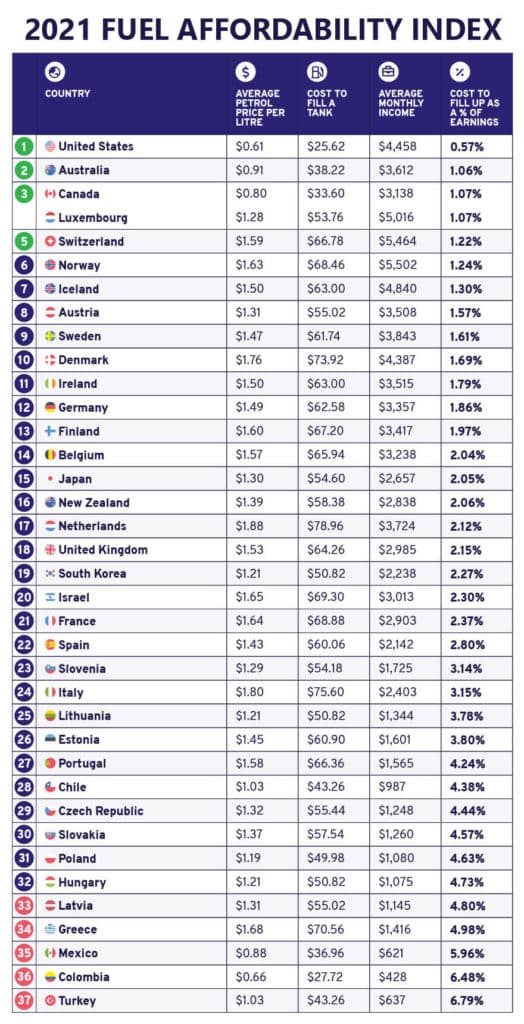This year has seen fuel prices fluctuate a lot all around the world. The changes in the prices of petrol and diesel have a direct impact on our day-to-day lives, whether through traveling, cooking or even inflation.
This is because petrol and diesel prices are linked to crude oil prices. The Organization of Petroleum Exporting Countries (OPEC) sets crude oil prices; when crude oil prices go up, so do petrol and diesel prices.
Fuel Prices in California
The average price of a gallon of gasoline in California was $3.70 in July 2018, and by October that same year, the average price per gallon had risen to $3.98. This was due to crude oil prices rising from $70 a barrel in early October to over $80 a barrel. The rise in fuel prices had a direct impact on the cost of living in California, as well as the state’s economy.
In 2021, the fuel prices went past the $4 mark, reaching a high of $4.95 in January. This was due to the COVID-19 pandemic, which as well as affecting industries and sectors all over the world, also influenced the crude oil prices. With lockdowns implemented in many parts of the world, the demand for crude oil decreased, leading to a fall in prices. However, this was short-lived, as the prices started to increase again due to factors such as the US-China trade war and tensions in the Middle East.
2022 has been a roller coaster ride for fuel prices. The year started with prices dropping to $4.66 per gallon in February. A hike to $5.65 per gallon followed this in March. In June, fuel prices in California hit an all-time high of $6.29 per gallon.
California continues to be one of the states with the highest fuel prices in the US. This is due to several factors, such as the state’s high gasoline taxes, environmental regulations, and the fact that California is not part of the federal government’s crude oil pipeline system.
However, as seen in the Fuel index by Comparethemarket AU, price increases are a global problem and are not just limited to California. The rest of the world is also seeing a sharp rise in these prices.
In Europe, the prices of petrol and diesel have been on the rise since early 2018. This is due to several factors, such as the rise in crude oil prices, the depreciation of the Euro against the US dollar, and the introduction of new environmental taxes.
The rising fuel prices have a direct impact on the cost of living in Europe, as well as the economy of the continent.
For instance, Turkey has seen the most considerable increase in fuel prices, standing at 6.79%. Poland has seen a 4.63% increase, making it the fourth highest in Europe, only behind Greece (4.98%), Latvia (4.80%), and Hungary (4.73%).
Why Are Fuel Prices Increasing?
There are several reasons behind the recent increase in fuel prices. In 2021, you could trace most changes in fuel prices back to the COVID-19 pandemic, which decreased demand for crude oil.
The other factor that has impacted fuel prices is the situation in the Middle East. The region is home to some of the world’s largest oil-producing countries, such as Saudi Arabia, Iraq, and Iran. Tensions in the region, such as the Saudi Arabia-Iran conflict, directly impact crude oil prices.
Only recently, other factors such as the US-China trade war have started to impact fuel prices. The tensions between the US and China increased crude oil prices as investors feared the trade war would decrease demand for crude oil.
The increase in 2022 can be linked to the conflict between Russia and Ukraine. With Russia being among the largest crude oil producers, the conflict led to concerns about the stability of the global oil supply. This increased crude oil prices, which were passed on to consumers through higher fuel prices.
What is Being Done to Lower Fuel Prices?
The federal government aims to authorize E-15 gasoline sales starting this summer. The new blends will have 15% ethanol content compared to the current 10%. This is being done to boost the renewable fuels industry and reduce dependence on foreign oil.
The government is also considering the implementation of a tax holiday on fuel. It means there would be no federal excise tax on gasoline for some time. This would lead to a decrease in the price of gasoline, as the tax accounts for 18.4 cents per gallon.
Additionally, the government looks to release oil from the strategic reserves if crude oil prices continue to rise. This would help increase the supply of oil and lead to a decrease in fuel prices.
How Can You Save on Fuel?
With the high fuel prices, it’s only natural for people to look for ways to save on fuel. You can start by ensuring your car is maintained properly, including inflating the tires, getting regular oil changes, and ensuring the engine runs efficiently.
You can also try consolidating your errands, so you’re not making multiple trips; this will help you save on both fuel and time. You can also look into alternatives to driving, such as taking public transportation, carpooling, or biking.
Finally, you can shop around for the best fuel prices, including looking for discounts and loyalty programs. You can also use a gas rewards credit card to get cash back on your fuel purchases.

